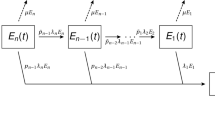Abstract
Some mathematical epidemic equation of SEIR with diffusion, which appears as a model of COVID-19 for the spread of disease-causing, is treated. The asymptotic properties of the diffusive equation are studied by applying the strong maximum principle, strong fading memory property and some Lyapunov function.




Similar content being viewed by others
Data availability
Basically, our work proceeds within a theoretical and mathematical approach, and we confirm that especially all data in the example quoted during this study are included in this published article in the references below.
References
R.M. Anderson and R.M. May, Population biology of infectious diseases, Part 1, Nature 280 (1979), 361-367.
R.M. Anderson, H. Heesterbeek, D. Klinkenberg and T.D. Hollingsworth, How will country-based mitigation measures influence the course of the COVID-19 epidemic? The Lancet 395 (2020), 931-934.
C. Bommer and S. Vollmer, Average detection rate of SARS-CoV-2 infections has improved since our last estimates but is still as low as nine percent on March 30th. URL: https://www. uni-goettingen.de/en/606540..html (04/09/2020).
F. Brauer and C. Castillo-Chavez, Mathematical Model in Population Biology and Epidemiology, Vol. 2, Springer New York (2012), 3-47.
K. Gopalsamy, Stability and Oscillations in Delay Differential Equations of Population Dynamics, Kluwer Academic Publishers, Dordrecht, 1992.
M. Granovetter, Threshold Models of Collective Behavior, The Sociological Quarterly, 1983.
Y. Hamaya, On the asymptotic behavior of a diffusive epidemic model (AIDS), Nonlinear Analysis 36 (1999), 685-696.
Y. Hamaya and T. Arai, Permanence of an SIR epidemic model with diffusion, Nonlinear Stadies 17 (2010), 69-79.
Y. Hamaya and K. Saito, Global asymptotic stability of a delayed SIR epidemic model with diffusion, Libertas Mathematica (new series), 36 (2016), 53-72.
Y. Hamaya and K. Saito, On the global attractivity of a SEIR epidemic model with diffusion, submitted.
J. Hellewell, S. Abbott, A. Gimma, N. I. Bosse, C. I. Jarvis, T. W. Russell, J. D. Munday, A. J. Kucharski and W. J. Edmunds, Feasibility of controlling COVID-19 outbreaks by isolation of cases and contacts, Lancet Glob. Health, 8 (2020), e488-e496.
H. Inaba, Mathematical Models for Demography and Epidemics, Expanded Edition, University of Tokyo Press, 2020.
Johns Hopkins Corona virus Resource Center, 2020, https://coronavirus.jhu.edu/map.html.
W. O. Kermack and A. G. Mckendrick, A contribution to the mathematical theory of epidemics, P. Roy. Soc. A, Math. Phys. Eng. Sci., 115 (1927), 700-721.
N.M. Linton, T. Kobayashi, Y. Yang, K. Hayashi, A.R. Akhmetzhanov, S. Jung, B. Yuan, R. Kinoshita and H. Nishiura, Incubation period and other epidemiological characteristics of 2019 novel coronavirus infections with right truncation: a statistical analysis of publicly available case data, Jour. Clini. Medi. 9, (2020), 538.
Y. Liu, A.A. Gayle, A. Wilder-Smith and J. Rocklov, The reproductive number of COVID-19 is higher compared to SARS coronavirus, Jour. Travel Medi. 27 (2020) taaa021.
S. Murakami and Y. Hamaya, Global attractivity in an integrodifferential equation with diffusion, Differential Equations and Dynamical Systems, 3 (1995), 35-42.
N.S. Padhye, Reconstructed diagnostic sensitivity and specificity of the RT-PCR test for COVID-19, medRxiv. (2020) https://doi.org/10.1101/2020.04.24.20078949.
A. Pazy, Semigroups of Linear Operators and Applications to Partial Differential Equations, Applied Math. Sci. Springer-Verlag, New York, 1983.
M.H. Protter and H.F. Weinberger, Maximum Principles in Differential Equations, Springer-Verlag New York Inc., 1984.
R. Redlinger, On Volterra’s population equation with diffusion, SIAM J. Math. Anal. 16 (1985), 135-142.
C. del Rio and P. N. Malani, COVID-19 - New insights on a rapidly changing epidemic, JAMA, (2020), https://doi.org/10.1001/jama.2020.3072.
K. Saito, On the global stability of an SIR epidemic discrete model, submitted.
K. Saito, T. Kohno and Y. Hamaya, Global stability of a delayed SIR epidemic model with diffusion, International Journal of Differential Equations and Applications, 16 (2017), 123-145.
K. Saito, T. Kohno and Y. Hamaya, Asymptotic behavior of delayed SIR epidemic models of COVID-19 with diffusion, Advances in Pure Mathematics, 13 (2023), 221-225.
Statistics Bureau of Japan, Population estimates monthly report, URL:http://www. stat.go.jp/english/data/jinsui/tsuki/index.html (04/09/2020).
Y. Takeuchi and W. Ma, Stability analysis on a delayed SIR epidemic model with density dependent birth process, Dynamical and Continuous Discrete Impul. Systems, 5 (1999), 171-184.
World Health Organization, Coronavirus disease 2019 (CCOVID-19) situation reports, URL:http://www. who.int/emergencies/diseases/novel-coronavirus-2019/situation-reports/ (15/09/2020).
C. Yang and J. A. Wang, Mathematical model for the novel corona virus epidemic in Wuhan, China, Math. Biosci. Eng., 17 (2020), 2708-2724.
Y. Zhang, Xi. Yu, H. G. Sun, G. R. Tick, W. Wei and B. Jin, COVID-19 infection and recovery in various countries: Modeling the dynamics and evaluating the non-pharmaceutical mitigation scenarios, submitted on 31 Mar 2020 to Cornell University.
Acknowledgements
The authors wish to thank referees gratitude for their many useful comments concerning the content of this paper.
Funding
We are partially supported by JSPS KAKENHI Grant Number 21K03318 in Japan.
Author information
Authors and Affiliations
Corresponding author
Ethics declarations
Conflict of interest
The authors declare no competing interests.
Rights and permissions
Springer Nature or its licensor (e.g. a society or other partner) holds exclusive rights to this article under a publishing agreement with the author(s) or other rightsholder(s); author self-archiving of the accepted manuscript version of this article is solely governed by the terms of such publishing agreement and applicable law.
About this article
Cite this article
Hamaya, Y., Saito, K. GLOBAL ATTRACTIVITY OF A DELAYED SEIR EPIDEMIC MODEL OF COVID-19 WITH DIFFUSION. J Math Sci 271, 378–399 (2023). https://doi.org/10.1007/s10958-023-06527-6
Accepted:
Published:
Issue Date:
DOI: https://doi.org/10.1007/s10958-023-06527-6
Keywords
- Delayed SEIR epidemic model of COVID-19 with diffusion
- Global asymptotic stability
- Strong maximum principle




